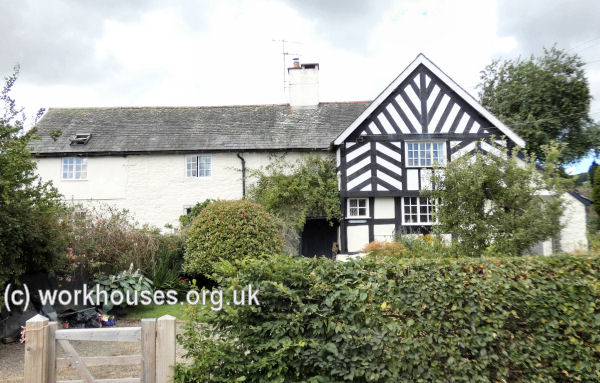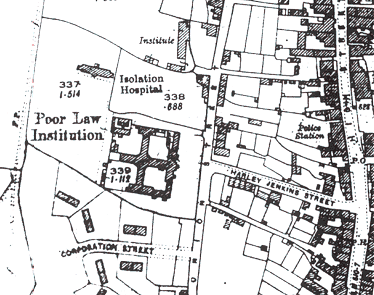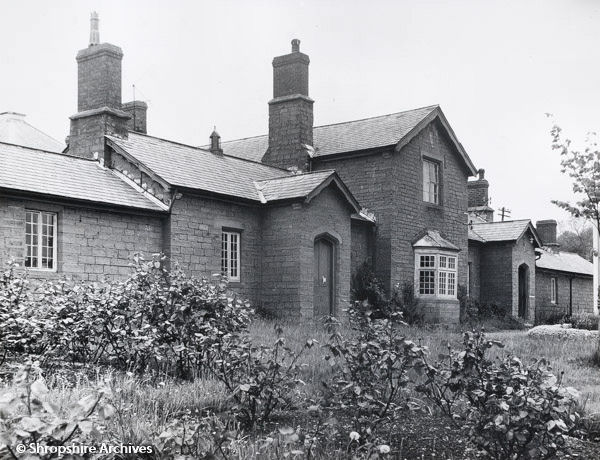Clun, Shropshire
Up to 1834
Bishop's Castle's workhouse, located on Church Street, was described by Eden, in his 1797 survey of the poor in England:
Table of diet in the Workhouse: Breakfast—every day, broth, or milk and water gruel. Dinner—Sunday, Wednesday, hot meat and vegetables; other days, cold meat and vegetables. Supper—every day, same as at breakfast. No bread is allowed at dinner. Sometimes potatoes and milk are served for supper. The matron always gives each person a little bread and cheese after breakfast. The house is kept pretty clean: of 10 beds 6 are stuffed with feathers and 4 with chaff. Both beds and bedclothes are very old, A committee of 12 gentlemen visit the Workhouse very regularly. The rates have varied from 1s. in the pound on the full rental to 1s. 4½d. since 1691 (in 1795, 1s. 2d.). The Poor in the hamlet are relieved at their own houses. 20 regular pensioners receive 31s. a week. Some have casual relief, and several have their rents paid by the hamlet. The rates were, in 1795, 1s. 2d. in the pound.
Clun had a parish workhouse which occupied a former malthouse just off the south side of the High Street.
Lydbury North's workhouse was a large building at the west of the village, now two houses known as Tudor Cottage and Gravenor House.

Former Lydbury North workhouse, 2020.
© Peter Higginbotham.
Lydham had a workhouse by 1776, when it could hold twelve inmates.
After 1834
The Clun Poor Law Union formally came into being on 18th July 1836. Its operation was overseen by an elected Board of Guardians, 21 in number, representing its 19 constituent parishes as listed below (figures in brackets indicate numbers of Guardians if more than one):
County of Salop:
Bishop's Castle borough (2), Bishop's Castle parish, Clun (2), Clunbury, Clungunford, Edgton, Hopesay, Hopton Castle, Lydbury North, Lydham, Mainstone, More, Myndtown, Norbury,
Ratlinghope, Shelve, Wentnor.
Counties of Salop and Montgomery: Hyssington.
County of Montgomery: Snead.
Later Additions: Dinmore (1862-84), Hill End (1862-84), Horderley Hall (1862-84), Mucklewick (c.1837), Old Church Moor (1862-84).
The population falling within the union at the 1831 census had been 9,870 with parishes ranging in size from Myndtown (population 36) to Clun itself (1,996). The average annual poor-rate expenditure for the period 1834-36 had been £4,155 or 8s.5d. per head of the population.
The new Clun Union initially made use of former parish workhouses in Clun and Bishop's Castle. The latter was used to house children and in 1842, William and Ann Robertson were in charge of the establishment.
A new Clun Union workhouse was erected on Union Street in Bishop's Castle in 1842-4. Designed by JH Whitling and Edward Haycock, it cost £3,845 and could accommodate 150 inmates. The workhouse location and layout are shown on the 1924 map below by which time the workhouse was officially know as Clun Poor Law Institution:

Clun workhouse site, 1924
Based on the popular cruciform layout, it had an entrance block at the east which rose to two storeys at the centre. To the rear, the accommodation ranges for the various classes of inmate radiated from the octagonal hub. The north and south ranges had cross-wings at their far ends. A separate isolation hospital was erected the north-west of the main workhouse.
In 1904, to help avoid stigma in later life, the birth certificates of those born in the workhouse recorded the location as Stone House, Clun.
The old buildings were demolished in the 1960s and replaced by a new hospital and care home for the elderly.

Former Clun workhouse from the south-east, 1964.
© Shropshire Archives.
Staff
Inmates
Records
Note: many repositories impose a closure period of up to 100 years for records identifying individuals. Before travelling a long distance, always check that the records you want to consult will be available.
- Shropshire Archives, Castle Gates, Shrewsbury, Shropshire SY1 2AQ. Please note that records may contain gaps or have access restrictions - please check before visiting. Holdings include Guardians' minute books (1844-1927); Register of inmates (1928-45); Births register (1866-1939); Deaths (1866-1951); Creed register (1914-30); Pauper children discharged to service (1886-7); etc.
Bibliography
- Higginbotham, Peter The Workhouse Encyclopedia (2014, The History Press)
Links
- None.
Unless otherwise indicated, this page () is copyright Peter Higginbotham. Contents may not be reproduced without permission.


